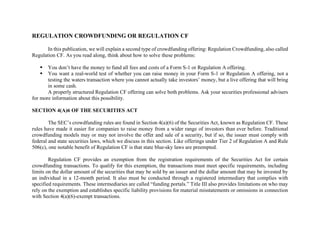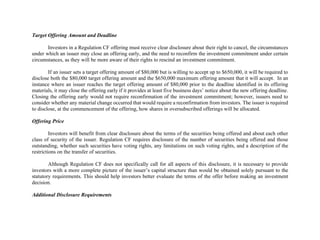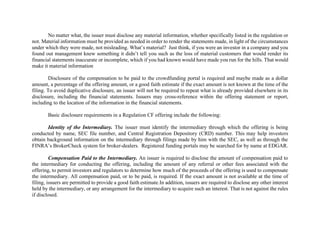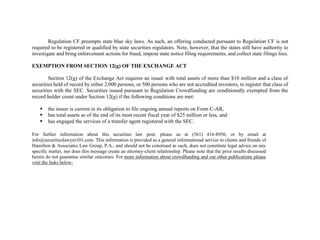Regulation Crowdfunding (Regulation CF) allows companies to raise capital from a broader range of investors without the burdens of traditional securities registration, provided they meet specific SEC requirements. Key elements include a maximum offering amount of $1.07 million within a 12-month period, limits on individual investor contributions based on income or net worth, and the requirement to use registered intermediaries known as funding portals for conducting offerings. This regulatory framework aims to facilitate capital raising for startups and small businesses while ensuring investor protections through disclosure and compliance measures.











![beneficial owner of 20 percent or more of the issuer’s outstanding voting equity securities.
In addition, issuers are required to disclose only related-party transactions that, in the aggregate, are in excess of
five percent of the aggregate amount of capital raised by the issuer during the preceding 12-month period, inclusive of
the amount the issuer seeks to raise in the current offering under Section 4(a)(6). Any series of similar transactions,
arrangements, or relationships should be aggregated for purposes of determining whether related-party transactions
should be disclosed.
For example, an issuer seeking to raise $1 million will be required to disclose related-party transactions that, in
the aggregate, are in excess of $50,000, which is the same dollar threshold required in Form 1-A for offerings of any size
made pursuant to Tier 1 of Regulation A, and an issuer that raises $250,000 will be required to disclose such transactions
in excess of $12,500.
There is a definition for “member of the family” in the related-party transactions context that is consistent with
the definition of “member of the family of the purchaser or the equivalent” in the resale restrictions context. A “member
of the family” is defined as a “child, stepchild, grandchild, parent, stepparent, grandparent, spouse or spousal equivalent,
sibling, mother-in-law, father-in-law, son-in-law, daughter-in-law, brother-in-law, or sister-in-law, [including] adoptive
relationships” of any of the persons identified.
Other Disclosures
There are three other issuer disclosures required by Regulation CF:
▪ An issuer must disclose on its website the location where investors will be able to find its annual report and the
date by which such report will be available on its website.
▪ The disclosure must include any material information necessary in order to make the statements made, in light of
the circumstances under which they were made, not misleading. This provision should help ensure that investors
have all the material information they need on which to base their investment decisions.
▪ The issuer must disclose whether it or any of its predecessors previously failed to comply with the ongoing
reporting requirements of Regulation Crowdfunding.](https://image.slidesharecdn.com/regulationcf-200405160611/85/Regulation-cf-12-320.jpg)







